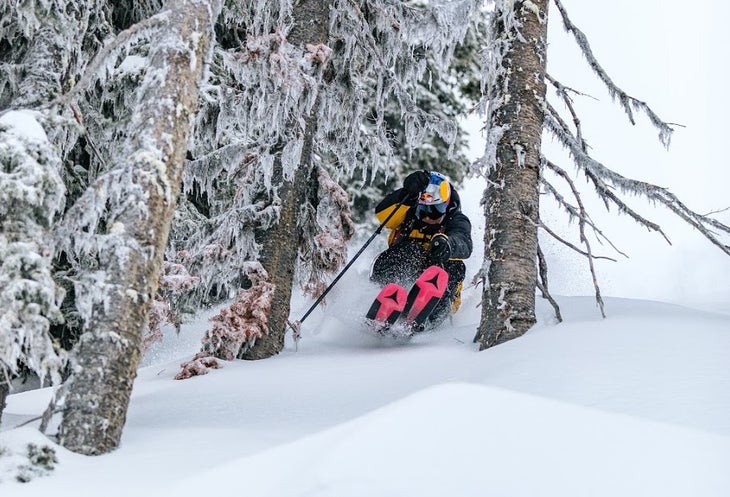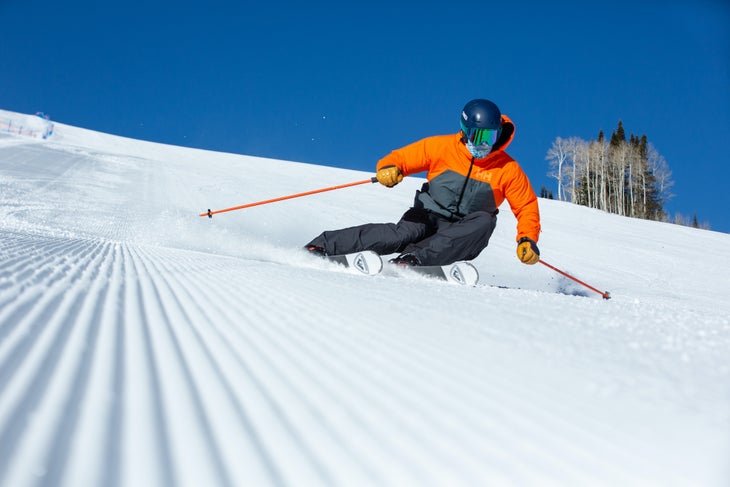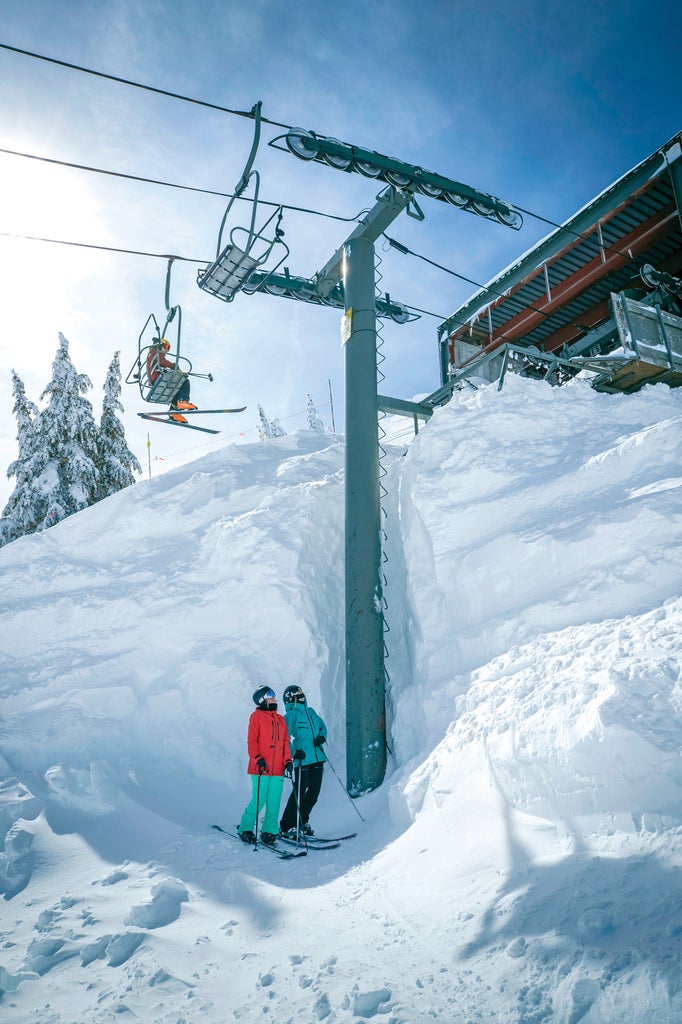Products You May Like
Skiers are generally an agreeable bunch—most of us prefer to live and let live. But there’s just one thing we can’t seem to agree on as a group: How fat is too fat when it comes to skis?
East Coasters think skiers who ski on fat boards with more than 100mm underfoot are kidding themselves; skiers in the West think Eastern skiers are missing all the fun on their narrow, carvy sticks.
We’ll take partial blame for the discord. After all, one season we’re telling you that wider all-mountain skis are the way to go, the next we’re talking up narrower-waisted skis. But that’s because ski manufacturers keep experimenting with designs, technologies, and materials. After years of swinging for the fences in the all-mountain category, ski manufacturers are now slowly reining in waist widths again because they’ve found ways to marry the best aspects of wider skis with a narrower waist width, which perform better on groomed snow and are lighter weight.
So now the question is, do skiers even need skis with more than 110mm underfoot anymore? How wide is too wide for resort skiers who ski the whole mountain?
SKI’s gear test director Jenny Wiegand put this question to two skiers who have seen the waist-width debate go round in circles for years: U.S. speed skiing legend Daron Rahlves, and professional ski instructor and coach for the PSIA Alpine Team, Michael Rogan.
After retiring from ski racing in 2006, Rahlves swapped his skinny racing skis for fat powder boards and has been freeskiing primarily around Tahoe, Calif. ever since. He’s also a brand ambassador for Atomic and has helped the brand develop and design their freeski line over the past two decades. Rogan, a Nordica ambassador, calls Heavenly, Calif. home, where he spends much of his time teaching skiing to clients and fellow ski instructors.
We figured if anyone knows what skis are the best tool for the job in soft, Western conditions, it’s these two.
Jenny Wiegand: I’m always amazed by how many skiers I see on big, all-mountain skis with around 105mm underfoot at the very beginning of the ski season. Yes, we’re blessed with softer snow here in the Rockies, but it’s still firm and thin in the early season. I find myself wondering if these skiers only own one pair of skis, and this is the ski they chose as their one-ski quiver; or if they own multiple skis, and they choose to ski 105mm underfoot in November—either because they prefer this width, or because 105mm is the skinniest ski they own.
Michael Rogan: I say those skiers suffer from delusions of grandeur.
Daron Rahlves: I get it. Going back to my transition from racing—or even when I was racing—I was freeskiing back at home in Tahoe. Everything was telling skiers to “go big, go wide, go long.” At that time I was skiing on the Atomic Atlas, which was 125mm underfoot in a 192cm length, and it was just a big ski. Whenever I wasn’t on race skis, I was on that.

JW: A ski with 125mm underfoot just sounds exhausting to me. That’s a lot of ski to try to throw around unless you’re skiing blower pow.
DR: Yeah, my ankles were so worked and beat up because I was fighting so much to get those skis to hold an edge. I would ski them on hardpack, on chalk. They were awesome on pow days, but not great otherwise. But I skied those for a couple of seasons before I started moving to skinnier skis because those fat skis would beat me up too much in everyday conditions.
JW: I think most recreational skiers know they don’t need to own a pair of 125mm skis, but you do see a lot of resort skiers on skis around 105mm underfoot now. Even skiers who spend a lot of time on-trail. While I’ve argued that some wider all-mountain skis can get the job done on hardpack and groomed runs, they still may not be the best tool for the job, even out West.
MR: Most people’s idea of skiing and my idea of skiing are very different. Any ski can do anything, for the most part. You can get the ones that aren’t made to carve, to carve—it takes a little bit more effort, but you can do it. And you can get the ones that are made to carve to skid, it just takes a little more know-how, or understanding and effort. People who only ski 100mm or above waist-widths when the snow is hard don’t appreciate how to make real turns on that type of snow—or, they just have a different idea of what a turn is.
Related: Can Wider All-Mountain Skis Hack it Back East?

DR: If you just want to slide down the mountain and use your skis like windshield wipers, a wide ski will be more effortless. A wider ski can be easier because you can get away with more stuff.
MR: From a skills point of view, pressure control—or foot-to-foot movement—is one of the hardest skills to acquire, develop, or get good at. The narrower the ski is, the more demands it puts on your ability to have good pressure-control skills. So you can get a wider ski and have less skill and still get it done and be relatively successful.
JW: And that right there is a huge benefit of wide skis—they’ve made skiing, and especially skiing off-piste, way more accessible to intermediate skiers. And that’s a good thing.
MR: Yes you can’t argue with the fact that they’ve made off-piste or ungroomed skiing easier. Most people just want to be efficient, or energy-conservationists, and to be able to ski for the full day. A wider ski on a lesser-skilled skier, because of its width, promotes skidding. A wider ski tends to be flatter, and flatter skis just prefer to skid, which makes skiing easier. It requires less pressure, and there’s less G-force created, and therefore it’s easier on your body from an energy-management standpoint. It might not be easier on your body because of the torque and twist and strain wider skis put on your joints, but from an energy standpoint, you can just let the ski skid.
On that topic: Are you carving or skidding? Here’s the difference
JW: I think this is a point that a lot of skiers don’t understand. A wider ski can be easier to ski in some situations because it allows you to skid or pivot turns—you don’t have to get it on edge to perform well. But a wider ski becomes more cumbersome and harder to swing around in moguls or in places where you want or need to make shorter turns or be more agile.
MR: I believe that’s true. Now, someone out there is going to disagree with that statement for sure. But that person is either a really good skier, or really good at how they ski. That’s a whole different conversation.
DR: Narrower skis are more versatile and easier on the ankles, for sure, especially on hard snow when you want to get an edge in. On a wide ski, you have to fight so hard to make a good turn on hard snow. And I just love that feeling of power in the turn you get from tipping skis on edge. You see a lot of skiers out West just throwing the skis to the side and sliding—they’re not really tipping up and arcing. And I just think that’s such an awesome feeling, when you do tip the ski and you feel them hold, and you feel that power and energy come out of them. It’s so hard to do that or feel that with a wider ski.
Related: Frontside vs. All-Mountain Skis—What’s the Difference?
JW: So what are you guys on for most of the season—what’s your quiver-killer?
DR: The last few years I was mostly skiing the Atomic Vantage 100 or 107. And this was out West, around Tahoe, where we have wide open terrain, softer snow, and you’re not stuck on the treeline groomers as much. The Vantage 107 worked out pretty well, but now I’ve made that next step down to an even narrower ski. My go-to, everyday ski is now the Atomic Maverick, which is 100mm underfoot. I can still lay down GS turns on that ski and it’s super stable on groomed runs. I went to Sun Valley last February and clocked like 86mph on that ski, and it was pretty darn stable. It’s just a great all-around ski if it’s not super icy or hardpack conditions, and it’s not knee-deep. It’s great for that in-between range.
But I am also so impressed with the Atomic Maverick 88. I didn’t get on that until the spring, but then it became the ski I was on the most. It’s such a good ski for strong skiers, especially those who can lay it over and make a really clean arc, but then want to be able to get off the groomers and check speed when they need to, or to slide into a turn. That ski is just a little more forgiving and versatile.
MR: I have a teaching ski that I built with Nordica that’s wider underfoot, for the purpose of not catching edges. Because skiers need to learn how to steer and skid first before they learn to edge and carve. That ski is 82mm underfoot. Then one of my favorite skis is the Nordica Enforcer 88. I do also have the Enforcer 104 Free, and I’ve had skis that are in the 110mm-range, but I rarely use them. For me, that sweet spot for everything I need or want to do is right around that 85-95mm range.
JW: And both of you ski primarily out West, and around Tahoe, which is notorious for deep powder. But your go-to ski for the average day out there is still an all-mountain ski in the 85mm-100mm range?

MR: I don’t really ski wider than 90mm underfoot, even on powder days. It’s got to be a big powder day for me to go wider than that. Fresh powder you only get for a run or two. Unless you’re able to find fresh powder every run [like when you’re heli-skiing or cat-skiing]—and if that’s the case, you’re going to have any ski you want because you’re probably not bringing yours or you have five or six pairs of skis.
I like to ski in the snow versus on top of the snow. A wider ski, when the snow gets tracked out, stays on top of things, where I can feel all the bouncing. Whereas if I take a narrower ski, I can get below the surface where I feel like it actually smooths out a little bit. The snow gets more consistent when you ski the bottom bit of the snow versus the top bit.
But if it’s a big powder day at Heavenly, say three feet of fresh, I’d say go as wide as you can find. By the end of the day you’re out of the sweet spot of the ski and the conditions, so there will be some struggles for sure. But if you can only choose one ski, and it’s a three-foot day, I would plan for the morning of that day and suffer with the afternoon of leftovers. Otherwise you’re going to suffer when it’s the best part of the day.
DR: The quiver-killer for me is still that 100mm underfoot. I’ve been skiing on a 107mm underfoot, either the Atomic Vantage or Backland, a bunch, because that to me even on a powder day is totally enough. And it’s still a good ski any day that there’s soft snow. But still, I like having a narrower ski like a mid-80mm to mid-90mm underfoot in my quiver.
Related: The Best Frontside Skis of the Year
JW: So final verdict—how wide is too wide when it comes to all-mountain skis for most recreational skiers?
DR: A lot of it is how you ski. If you’re surfy and like to float around on the snow, you want a wider ski. But if you like some power an want to rip some turns and have a ski you can really feel the performance out of on harder snow, then a narrower waist width is the direction to go with.
A lot of East Coasters in Tahoe go with a narrower ski, because they want that performance and that’s what they’re used to. But the skiers who grew up skiing powder all the time go with a wider ski, because that’s what they’re used to. I wouldn’t say they’re lazier skiers, they’re just spoiled.
MR: Waist width really comes down to what you value in skiing. If you value quick edge-to-edge movements, narrow is better than wide. If you value utilizing ski design for the purpose of making a turn or arc in the snow, more sidecut is better than less sidecut. If you like versatility and the ability to maneuver through tight spaces, rocker is better than camber. So I think it comes down to what we value.
It’s certainly been shown that the wider the ski is, the slower it is edge to edge—that’s just the way it is. And the wider it is, the more twisting potential the ski has, torsionally. So there’s a different sense of edge grip on wide skis, which often leads to bouncing and chattering or skidding.
And I’d say that for the average person on the average day at the resort, you’d get yourself in trouble by going too wide versus too narrow. A wider ski might be more of a detriment than a narrower one would be.
More Advice from the Gear Nerds
If you ski the East, this is the kind of ski you want underfoot
Reality check: most Rocky Mountain skiers are on skis that are too wide
Ladies, Don’t Let Shop Guys Sell You Short Skis
